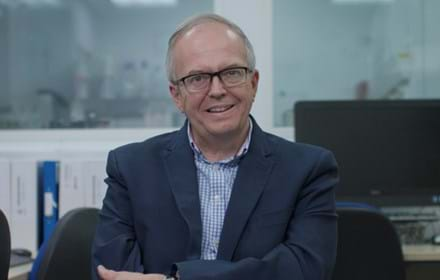
A trip around different drug classes in the world of diabetes
DRWF Research Manager Dr Eleanor Kennedy blog reports from Day Nine of the Diabetes UK Professional Conference.
The penultimate day of Diabetes UK’s Professional Conference starts with a big treat – the Dorothy Hodgkin Lecture. This year, entitled Genes, Drugs and Diabetes, it is presented by Professor Ewan Pearson who featured in an earlier blog (from Day Six).
Professor Calum Sutherland who introduced the session said that Professor Pearson’s work was important because “at a time when huge effort is being devoted to the discovery of new therapies for diabetes, Ewan has continually shown us that currently available and widely used therapies could be used much better by healthcare professionals”.
Professor Pearson began by reminding us just who the lecture is named after. Awarded the Nobel Prize for Chemistry in 1964 for solving the structure of vitamin B12, Dorothy Hodgkin also solved the molecular structure of porcine insulin just five years later.
Dorothy Hodgkin’s work was pivotal to our understanding of how insulin works
However, this lecture is going to be about how metformin works, how sulphonylureas work and why the glycaemic responses to GLP-1 receptor agonists can be so variable.
Starting with metformin, still the first line in clinical treatment of people type 2 diabetes, it is a drug that has been in constant use around the world since it was introduced in 1957 - 12 years before Dorothy Hodgkin solved the structure of insulin. And yet to this day, we are still not really clear about how exactly metformin works!
The textbooks tell us that insulin lowers hepatic glucose production, so we are introduced to the gene OCT1 as this transporter protein allows metformin uptake to the liver. But 8% of the white population have two common loss of function variants in the OCT1 gene. So, if this is how metformin works, then in individuals with this loss of function variant, metformin should not be taken up by the liver as effectively. In fact, patients with reduced OCT1 function still respond well to metformin.

How does metformin work?
Turning to a different genetic approach to find out how metformin works, Professor Pearson’s team has shown that actually genetic variants in a protein called GLUT1 alter metformin efficacy. One such genetic variant that is associated with reduced glut1 expression in liver and in the intestine as well as in the islets of Langerhans is associated with a greater glycaemic response to metformin and this effect is greater in an obese cohort. Preliminary studies in animal models point to the gut as the mediator of this effect.
Switching from metformin to sulfonylureas, a class of drug first identified in the 1940s, Professor Pearson explained how this class of drug has fallen out of favour thanks to weight gain, hypoglycaemia (low blood glucose levels), the lack of cardiovascular benefit and the misbelief that there is an increased cardiovascular risk.
However, again through some very neat genetic studies, Professor Pearson showed that sulfonylureas are actually the best drug for some patients including those with HNF1A maturity onset diabetes of the young and those with mutations that cause neonatal diabetes. Historically, sulphonylureas have been used at too high a dose causing potential harm. However, when used at low doses, this is cheap and effective drug - the perfect secretagogue causing minimal hypoglycaemia.
Professor Pearson finished his trip around drug classes in the world of diabetes by moving to the more modern drug class, GLP-1 receptor agonists. The response to this drug is highly variable and some genetic mutations or variants alter the glycaemic response. He demonstrated that in those with a Thr370Met variant in the arrestin beta1 gene, there is an increased response to GLP-1 receptor agonists because this variant causes an increased recycling of the GLP-1 receptor to the beta cell membrane resulting in an increased membrane expression of this receptor.
Professor Pearson concluded by saying that studying patients with genetic subtypes of diabetes and how drug response varies in patients with type 2 diabetes can provide novel insights into how diabetes drugs work with type 2 diabetes.
From here, I jump into a session entitled Bariatric Surgery.
Now, due to technical issues, this session doesn’t run as planned so, instead of starting with a talk on the real-world results from the National Bariatric Surgery Registry we go straight into one about glucose variability following bariatric surgery.
Glycaemia does change after bariatric or metabolic surgery and one complication that is gaining more visibility is post-bariatric hypoglycaemia (PBH).
PBH is important as it can lead to autonomic symptoms like tremors, palpitations, sweating and hunger as well as neuroglycopenic symptoms like irrational behaviours, syncope, seizures and even death. Such disabilities in terms of daily activities, impacting upon driving and work, for example, often occur after Roux-en-Y gastric bypass (RYGB) and sleeve gastrectomy procedures.
How common is post-bariatric hypoglycaemia (PBH)?
Well, therein lies the rub! As the speaker says, it very much depends on how you define PBH in the first place. The number of people hospitalised with PBH is relatively small which is why, until more recently, it was viewed as a very rare complication of surgery. However, with the advent of more widespread use of continuous glucose monitoring, episodes of hypoglycaemia after RYGB are found to be much more common that at first thought - and can be as high as 3 in every 4 patients.
To improve this, dietary intervention is key because pharmacological treatments can have variable efficacy.
Using an interesting case study, the speaker demonstrated that there is an additional factor to be considered though. A patient who had undergone successful RYGB surgery and whose type 2 diabetes was in remission presented with quite severe glycaemic variations that were leading to regular hospital admissions. Even with dietary advice, her glucose readings were still suboptimal so, with psychological intervention with dedicated specialist stuff, it was discovered that the patient had been bereaved and was comfort eating. With this added support, she improved her resilience and ability to cope demonstrating the importance of a holistic approach as well as personalised care, in order to help people on an individual basis.
With new pharmacological treatments, is it possible to observe significant weight loss without the need for surgical intervention?
One of the speakers in this session though so.
Orlistat is a low-cost drug but its effects on fat absorption often result in intolerable gastrointestinal side effects and because it is only effective whilst on the treatment, the clinical effect may be insufficient for the patient’s needs.
More novel drugs, liraglutide and semaglutide, are perhaps of more interest with the latter the subject of many randomised clinical trials that have recently reported or that are still underway. Both liraglutide and semaglutide are more likely to achieve more weight loss that orlistat and have additional benefits in preventing type 2 diabetes, cardiovascular disease and the progression of renal disease but they come at a high cost and currently only as injectable therapies making them less acceptable to some.
There is much work still to be done but, as with so much of the type 2 diabetes research field, one size clearly does not fit all – medicines and surgical options, alongside dietary and exercise interventions are all key and what works for one person may not work for another be it thanks to genetics or personal preferences, cost or availability. Day Nine has demonstrated all of this quite powerfully.
Read Lockdown guidance for staying home and safe for people living with diabetes during Covid-19 pandemic
Read How people with diabetes could become more ill if diagnosed with Covid-19
DRWF operations during the Covid-19 health crisis
The DRWF team is working remotely. Covid-19 guidance, particularly where it aligns or impacts with diabetes guidance, is shared as quickly as possible through the DRWF website and social media channels with the aim of making it as easy to understand as possible and a reliable source of latest news.
Further reports to follow – visit DRWF news page
Follow Dr Eleanor Kennedy on Twitter: @DRWFEleanor
Support DRWF by making a donation here
Find out more about DRWF-funded research here
Find out more about DRWF fundraising here
For latest update follow DRWF on Facebook, Instagram and Twitter
To receive the charity’s latest bulletins as they become available, please sign up here
Read DRWF diabetes information leaflets here
Join the Diabetes Wellness Network here
Recent News


